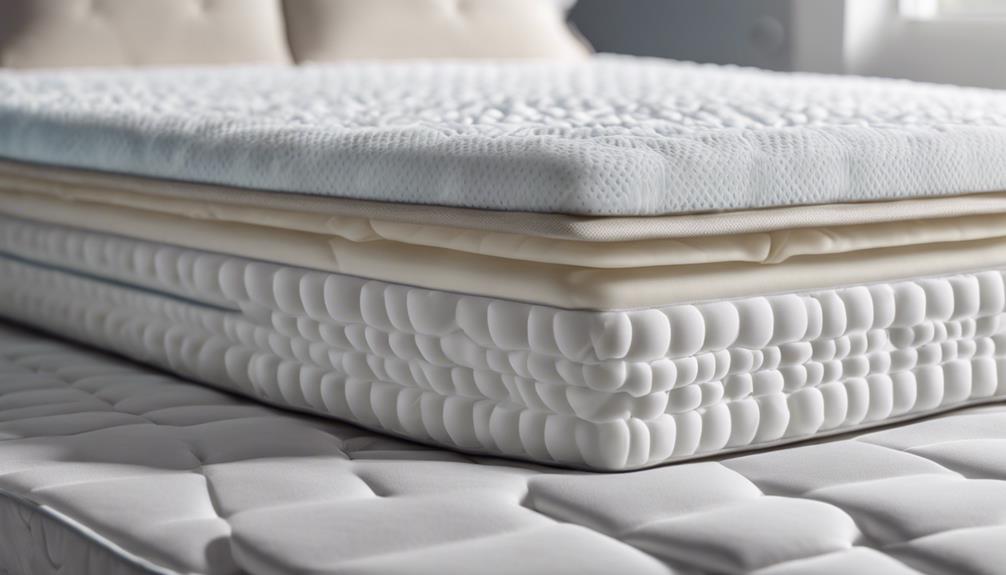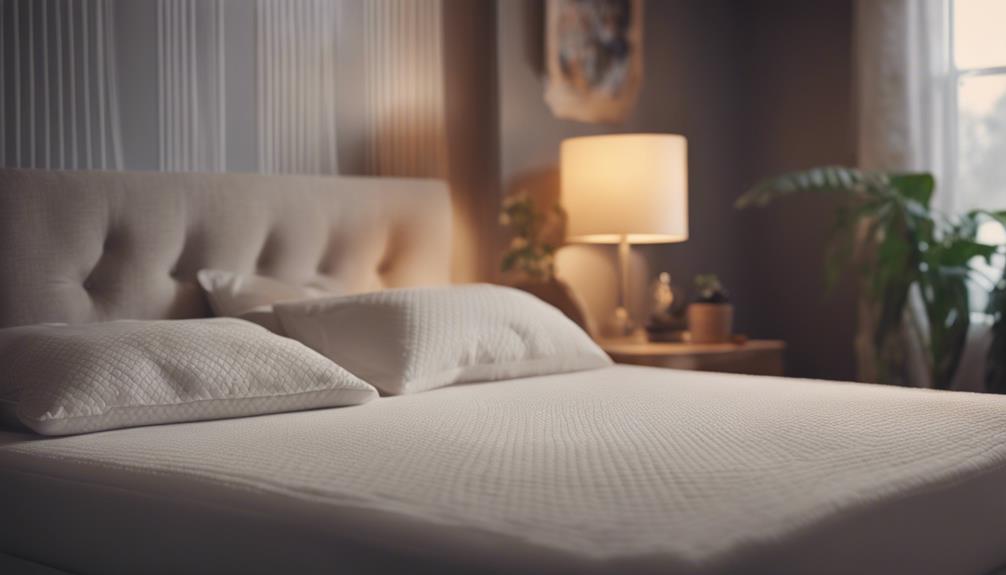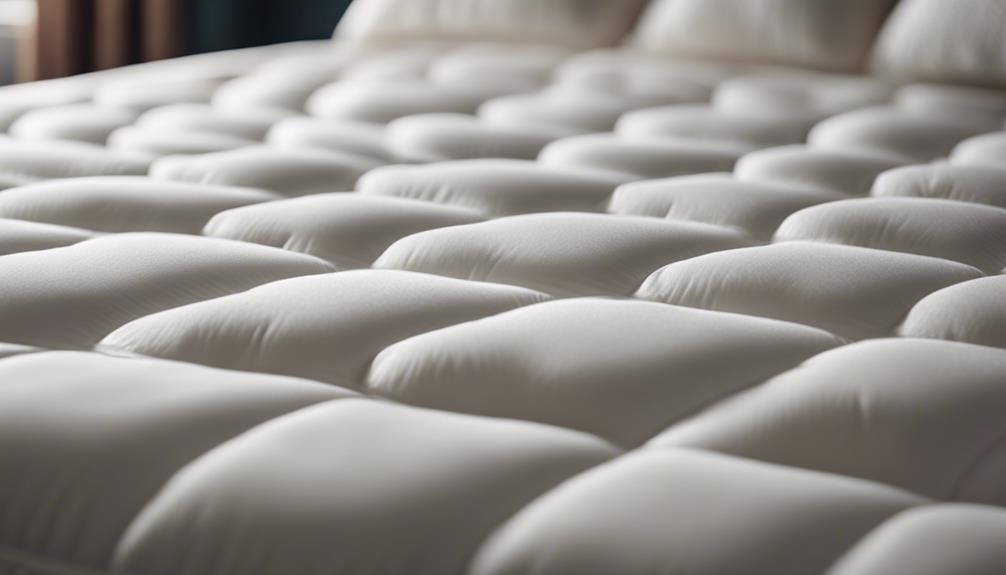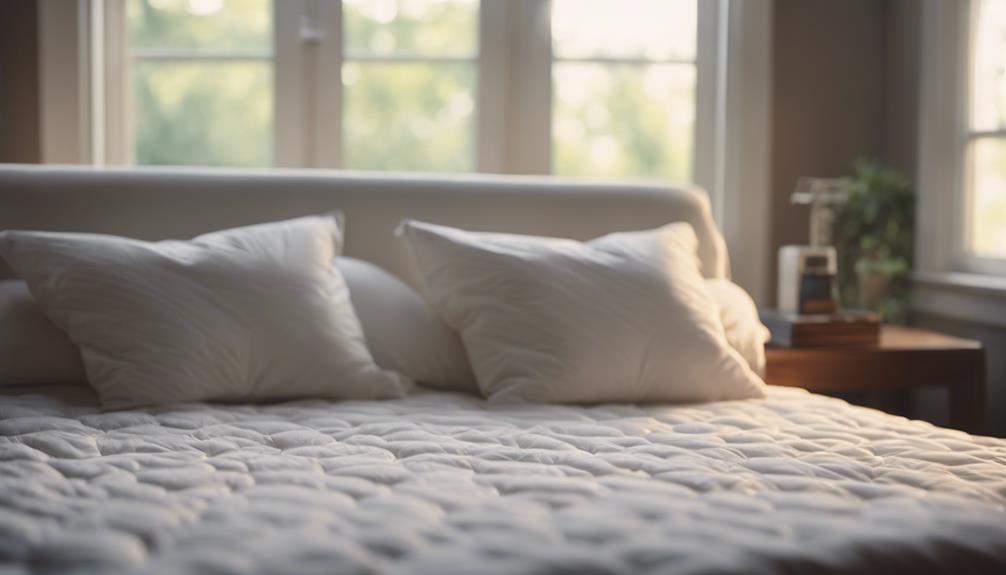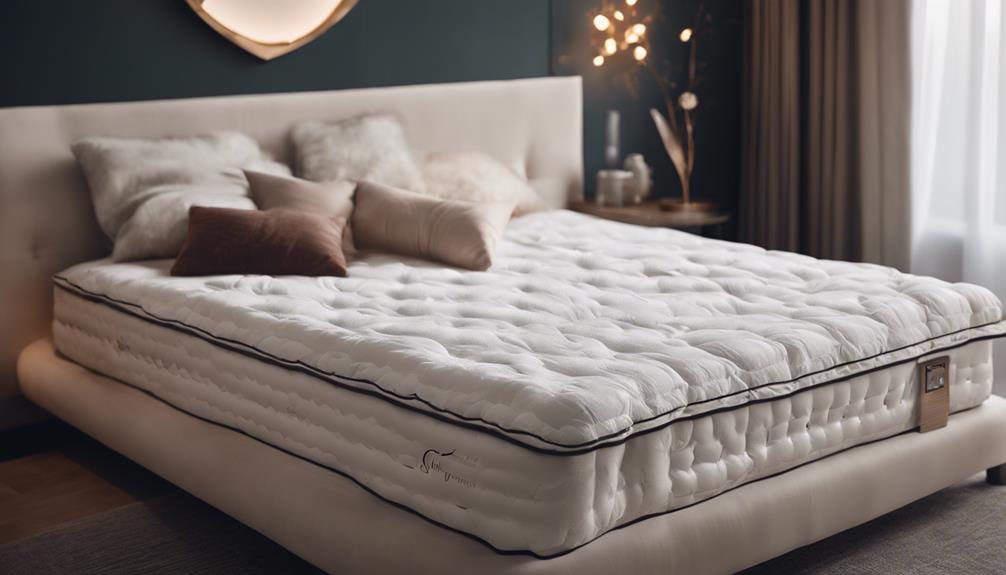Yes, you can stack mattress toppers, but it's not recommended. Stacking may create an uneven surface, reduce support, and pose safety risks. It can also impact the toppers' durability, causing quicker wear and tear. Memory foam and latex toppers are particularly vulnerable to deformation. Opting for a single, thicker topper is advised to maintain support and comfort. Proper air circulation is vital to prevent moisture buildup and mold growth. Storing toppers in ideal conditions helps preserve their quality and longevity. Understanding the risks and best practices for topper use is essential for a restful sleep experience.
Key Takeaways
- Stacking toppers can create an uneven surface, reducing comfort and support.
- Safety risks increase with elevated mattress height, especially for children and elderly.
- Allergens and bacteria can accumulate between stacked toppers, impacting hygiene.
- Durability of toppers can decrease due to increased pressure and compression.
- Opt for a single, thicker topper to prevent material compression and deformation.
Risks of Stacking Mattress Toppers
We've found that stacking mattress toppers can pose various risks that impact both comfort and health. When you stack different types of toppers, such as a memory foam topper on top of a latex one, you might end up with an uneven sleeping surface. This could lead to reduced back support and spinal misalignment, affecting the quality of your sleep. Improper alignment can result in discomfort and health issues over time.
Additionally, stacking toppers can increase the height of your mattress, causing your sheets to fit poorly and potentially creating safety hazards, especially for children or elderly individuals.
Moreover, health risks like allergen accumulation and bacterial growth can arise from the moisture trapped between stacked toppers. These conditions may exacerbate allergies or respiratory problems, impacting your overall well-being. To improve your sleep and minimize these health risks, it's advisable to use a single high-quality mattress topper that meets your comfort and support needs without the need for stacking.
Impact on Toppers' Durability
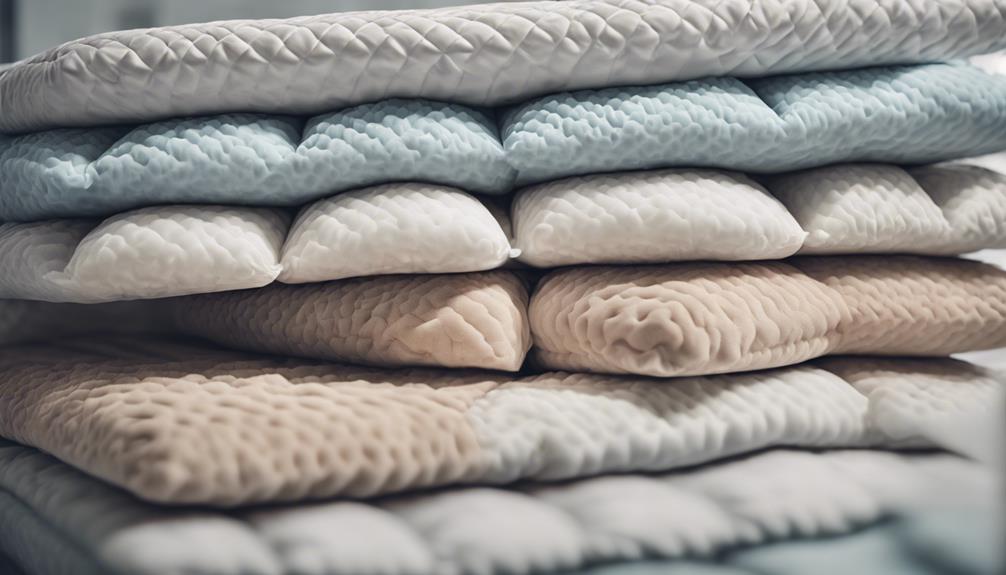
Layering mattress toppers can greatly reduce their durability by subjecting them to increased pressure and compression, leading to quicker wear and tear on the materials. When stacking multiple toppers, such as memory foam or latex toppers, the weight distribution and stress can cause them to lose their original shape and support over time.
Memory foam and latex toppers are particularly vulnerable to compression and deformation when stacked on top of each other. This can result in a decrease in their overall lifespan and comfort. To maintain the integrity and longevity of your mattress toppers, it's advisable to avoid stacking them.
Material Compression and Deformation

Material compression and deformation often occur when stacking mattress toppers, particularly with memory foam and latex varieties. Continuous pressure from stacking can cause these materials to lose their original shape, leading to a decrease in support and comfort over time. Memory foam and latex toppers are vulnerable to compression, which may impact the overall performance of the toppers.
To avoid material compression and deformation, it's recommended to opt for a single, thicker topper instead of stacking multiple layers. By choosing a thicker topper, you can reduce the likelihood of excessive pressure that contributes to material deformation. This approach helps maintain the integrity of the memory foam or latex material, ensuring that it retains its supportive and comfortable properties for a longer period.
When considering stacking mattress toppers, be mindful of the potential effects of material compression and deformation on the overall quality of your sleep surface. Opting for a single, high-quality topper can help mitigate these concerns, enhancing the longevity and performance of your bedding.
Air Circulation and Moisture Concerns
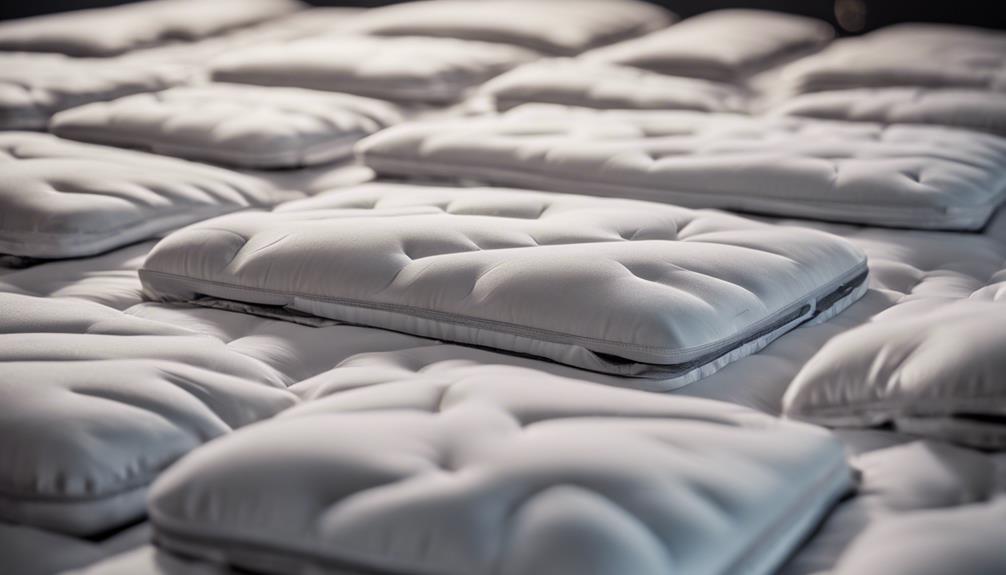
When stacking mattress toppers, it's important to consider how air circulation plays a key role in preventing moisture buildup and potential mold growth between the layers. Moisture trapped between stacked toppers can compromise the material integrity and hygiene of the bedding.
To avoid this, proper spacing and ventilation between toppers are essential. Inadequate air circulation in stacked toppers may contribute to odors and discomfort during sleep. Addressing air circulation concerns is essential to preserve the quality and performance of the mattress topper.
Without sufficient airflow, moisture buildup becomes more likely, leading to potential issues. Hence, when stacking mattress toppers, it's crucial to create pathways for air to flow between the layers, preventing any trapped moisture. This simple step can go a long way in maintaining the freshness and longevity of the stacked toppers, ensuring a comfortable and healthy sleeping environment.
Storage Recommendations for Toppers
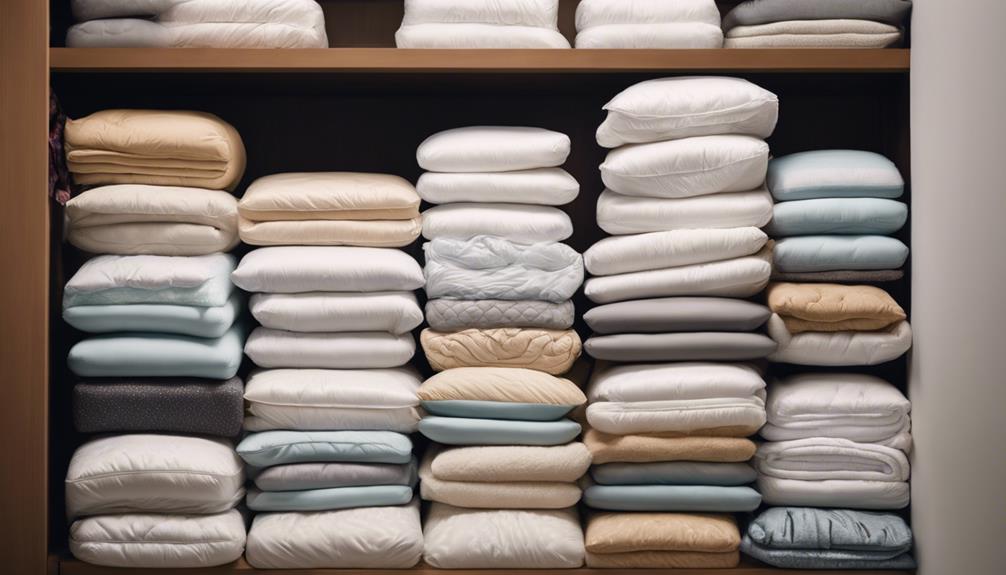
To maintain the quality and longevity of your mattress toppers, proper storage in controlled humidity and stable temperatures is crucial. When storing your mattress toppers, consider the following recommendations:
- Ideal Storage Locations: Choose areas such as closets, spare beds, or under the bed for storing your mattress toppers. If using attics or storage units, exercise caution to guarantee exposure to extreme temperatures or humidity fluctuations.
- Breathable Storage Bags: Opt for storage bags made of breathable materials to allow air circulation. These bags help prevent moisture buildup, maintain freshness, and safeguard against dust and allergens.
- Material Considerations: Select storage bags with secure closures, washable features, and UV protection to safeguard the longevity of your mattress toppers.
Best Practices for Maintaining Toppers
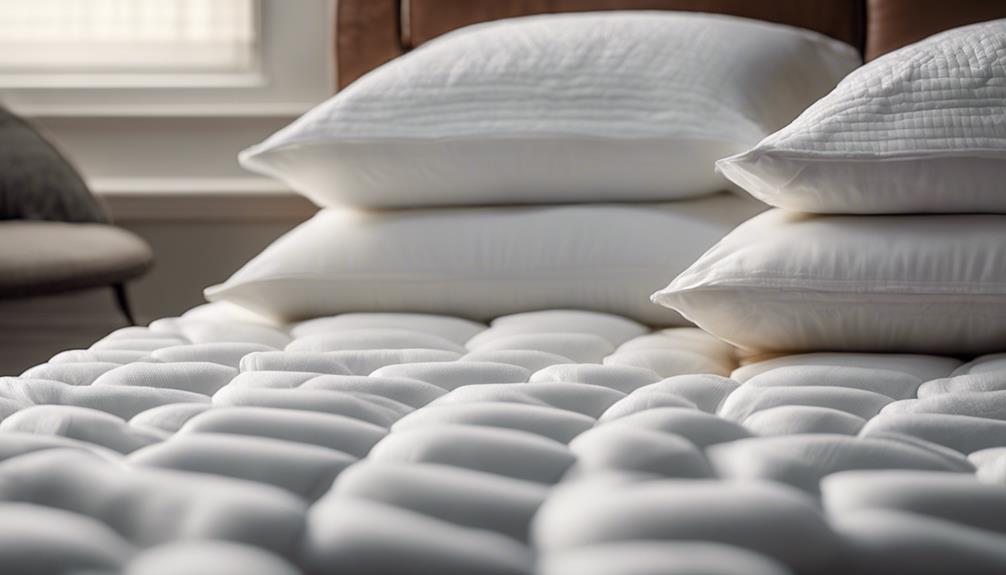
Maintaining mattress toppers is key to ensuring their longevity and performance.
Regularly rotating toppers promotes even wear, while using a mattress protector shields against spills and allergens.
Vacuuming periodically and following manufacturer's cleaning guidelines are essential steps in caring for toppers.
Cleaning Mattress Toppers
Regularly cleaning your mattress topper is crucial to maintaining its hygiene and prolonging its lifespan. Depending on the material of your topper, specific cleaning methods should be followed to guarantee its longevity and performance. Here are some basic cleaning tips for different types of mattress toppers:
- Memory Foam Toppers: Use mild detergent and water, then thoroughly rinse and air dry to maintain hygiene and prevent damage.
- Latex Toppers: Clean with mild soap and water, ensuring proper drying to prevent mold growth and preserve shape and quality.
- Feather or Down Toppers: Spot clean following care instructions, and ensure thorough drying to avoid odors and maintain freshness.
Regular cleaning not only keeps your mattress topper fresh but also helps in preventing odors and maintaining its quality.
Rotating for Even Wear
Implementing a regular rotation schedule for your mattress topper is essential for ensuring even wear and prolonging its lifespan. By rotating the topper regularly, you can prevent indentations and maintain uniform compression.
Switching the topper end to end and alternating its position every few months helps sustain consistent support and comfort. This practice also aids in distributing body weight evenly, reducing wear on specific areas.
Following a rotation schedule recommended by the mattress topper manufacturer is vital for preserving the topper's quality and performance. Remember, rotating your mattress topper is a simple yet effective way to extend its lifespan and make sure that you continue to enjoy a comfortable and supportive sleep surface for years to come.
Storage Tips for Toppers
Storing mattress toppers in suitable conditions is essential for preserving their quality and ensuring long-lasting comfort. When it comes to maintaining toppers, here are some best practices to keep in mind:
- Controlled Environment: Store in areas with stable temperatures and controlled humidity to prevent material damage.
- Proper Locations: Consider storing in closets, spare beds, or under beds to avoid dust and allergens.
- Breathable Storage Bags: Opt for breathable bags with secure closures and washable features to circulate air and prevent mold growth.
Following these proper storage practices can help prevent compression, deformation, and vulnerability of memory foam and latex toppers, ensuring their longevity and your comfort.
Frequently Asked Questions
How to Layer Mattress Toppers?
Layering mattress toppers is a great way to customize comfort and support. Start by selecting toppers with different materials and thickness for a personalized feel.
Guarantee proper sizing and compatibility to avoid fit issues when stacking toppers. Consider the overall height increase and impact on sheet fit when layering multiple toppers.
Experiment with various combinations to find the perfect balance of cushioning and support for a restful night's sleep.
Can You Put Two Memory Foam Mattresses on Top of Each Other?
Yes, stacking two memory foam mattresses isn't recommended. Doing so can result in uneven support, affecting comfort and overall performance.
Compression of the top mattress may lead to discomfort and reduced breathability, increasing heat retention. Memory foam mattresses are designed as standalone units for best sleep quality.
It's best to avoid stacking memory foam mattresses to guarantee a restful and supportive sleep experience.
Can You Put a Mattress Topper on Top of a Memory Foam Topper?
We can enhance comfort and support by placing a mattress topper on top of a memory foam topper. The additional topper adjusts firmness levels or provides extra cushioning as needed.
Compatibility depends on thickness, material, and personal preference. Consider the best possible height and feel of stacked toppers for top-notch sleep quality.
Experiment with different combinations to find the ideal comfort and support for our specific needs.
How to Store Mattress Toppers?
When storing mattress toppers, it's essential to keep them in a well-suited humidity environment to prevent moisture damage. Ideal storage places include closets, spare beds, under the bed, and cautiously in the attic.
To avoid mold, odors, dust, and allergens buildup, use breathable storage bags with secure closures. Remember to choose bags with washable features, UV protection, and the right size for effective topper storage.
Conclusion
To sum up, stacking mattress toppers may seem like a convenient way to customize comfort, but it can actually lead to premature wear and tear.
While some individuals may find temporary relief from adding extra layers, the long-term impact on the toppers' durability and performance is a significant concern.
To maintain the quality and lifespan of your mattress toppers, it's best to use them individually and follow proper storage and maintenance practices.
